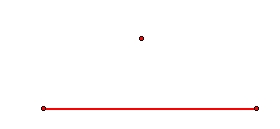
A non-Euclidean geometry is a geometry that does not satisfy Euclid's postulates.
If Playfair's postulate is false (and it is not always possible to draw exactly one line through the given point parallel to the line) then there are 2 possibilities:
1) There is some point and line so that there are no parallels (spherical geometry)
2) There is some point and line so that there are at least 2
parallels (hyperbolic geometry).

People debated about the validaty and necessity of Euclid's 5th postulate for thousands of years. While the geometries that arise from the negation of Euclid's 5th postulate (1) and 2) above) are certainly different than Euclidean geometry (Euclid's geometry) and also seem impossible, these new geometries do exist and are important. They represent a change in world view and require thinking that is "outside of the box".